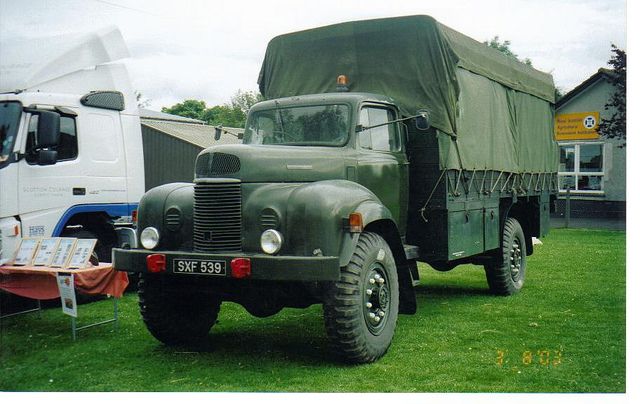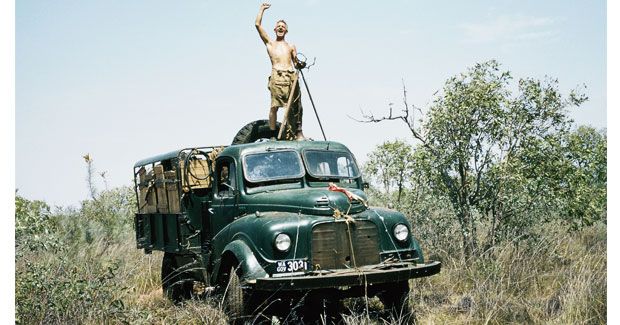Early Survey Vehicles
10 years 9 months ago #121325
by Lang
Early Survey Vehicles was created by Lang
Here is a very good overview with lots of photos, of the vehicles used by National Mapping in the 40's, 50's and 60's.
Lang
www.xnatmap.org/adnm/ops/prog/rafgeosvy/20.htm
Lang
www.xnatmap.org/adnm/ops/prog/rafgeosvy/20.htm
Please Log in to join the conversation.
Less
More
- Posts: 3497
- Thank you received: 307
10 years 9 months ago - 10 years 9 months ago #121326
by Roderick Smith
Replied by Roderick Smith on topic Re: Early Survey Vehicles
What an interesting link, and not just for the vehicles. It covers a whole period in history too.
The original survey of Australia was done by ground triangulation from a baseline on Mornington Peninsula. I don't have the era handy.
Look back today on the surveyors of the mid 1800s who created national resources (railways and the overland telegraph, and plotting mineral deposits) from manual instruments carried on horses & camels, and who spent their nights in tents under hurricane lanterns doing the calculations and plotting manually.
Aerial surveying came into use from about the 1930s.
My memory is of the survey ship Warrego. When I was living on Magnetic Island (1956), it came by, and the survey party climbed through rugged tropical scrub to the high point of the island to erect a trig point, then bashed back to the boat. The trig point was obscured. They had to bash back up again and reposition it.
Highways tended more to be formalising of bush tracks established by pioneering farmers. That shows clearly in the various threads on the evolution of Hume Hwy.
Into a later era, land surveying was a skill which Australia exported, and didn't just privatise to an overseas operator. Australia has done a lot of mapping for New Guinea and for Indonesia, all by air. Processing of such data requires a lot of sophisticated mathematics, and the advent of high-powered computing has been an important step forwards. I have studied a lot of the relevant mathematics, but never did have to teach it. In one of my overseas holidays, I visited the museum on the equator in Ecuador. It covers the importance of the area in the 1600s, when surveyors used a baseline there to compare with one in northern Scandinavia to establish that Earth isn't spherical (it is an oblate spheroid). Later in the same holiday I was in Greenwich (London, UK), covering surveying from a century later. Captain Cook came south to test a new chronometer, helping navigators establish longitude. Claiming Australia for the British crown was only part of the project.
Today, when you have your gps tell you where to turn next, the mathematics behind the automation was established by these people; the mathematics behind the positioning and speed calculations from signals bounced off geostatic satellites is essentially the same as the mathematics used by surveyors centuries and decades ago.
One of the aspects of the HCVC forum which I enjoy is the diversity: it covers far more than just the vehicles. People and applications are just as important. Vehicles are only a means to an end; they are not an end in themselves.
Roderick B Smith
Rail News Victoria Editor
The original survey of Australia was done by ground triangulation from a baseline on Mornington Peninsula. I don't have the era handy.
Look back today on the surveyors of the mid 1800s who created national resources (railways and the overland telegraph, and plotting mineral deposits) from manual instruments carried on horses & camels, and who spent their nights in tents under hurricane lanterns doing the calculations and plotting manually.
Aerial surveying came into use from about the 1930s.
My memory is of the survey ship Warrego. When I was living on Magnetic Island (1956), it came by, and the survey party climbed through rugged tropical scrub to the high point of the island to erect a trig point, then bashed back to the boat. The trig point was obscured. They had to bash back up again and reposition it.
Highways tended more to be formalising of bush tracks established by pioneering farmers. That shows clearly in the various threads on the evolution of Hume Hwy.
Into a later era, land surveying was a skill which Australia exported, and didn't just privatise to an overseas operator. Australia has done a lot of mapping for New Guinea and for Indonesia, all by air. Processing of such data requires a lot of sophisticated mathematics, and the advent of high-powered computing has been an important step forwards. I have studied a lot of the relevant mathematics, but never did have to teach it. In one of my overseas holidays, I visited the museum on the equator in Ecuador. It covers the importance of the area in the 1600s, when surveyors used a baseline there to compare with one in northern Scandinavia to establish that Earth isn't spherical (it is an oblate spheroid). Later in the same holiday I was in Greenwich (London, UK), covering surveying from a century later. Captain Cook came south to test a new chronometer, helping navigators establish longitude. Claiming Australia for the British crown was only part of the project.
Today, when you have your gps tell you where to turn next, the mathematics behind the automation was established by these people; the mathematics behind the positioning and speed calculations from signals bounced off geostatic satellites is essentially the same as the mathematics used by surveyors centuries and decades ago.
One of the aspects of the HCVC forum which I enjoy is the diversity: it covers far more than just the vehicles. People and applications are just as important. Vehicles are only a means to an end; they are not an end in themselves.
Roderick B Smith
Rail News Victoria Editor
Last edit: 10 years 9 months ago by Roderick Smith.
Please Log in to join the conversation.
Less
More
- Posts: 189
- Thank you received: 0
10 years 9 months ago #121327
by old scrapman
Replied by old scrapman on topic Re: Early Survey Vehicles
For anyone wanting a good read i can recommend the books by Len Beadell mentioned in the top post about surveying and road building by him and his crew.
Peter
Peter
Please Log in to join the conversation.
10 years 9 months ago - 10 years 9 months ago #121328
by Lang
Replied by Lang on topic Re: Early Survey Vehicles
Two vehicles interest me in particular. One is the 4x4 Morris Commercial - who knows anything about these.
The second is the light Commer 4x4?. Nothing in the text (they mention the bigger Commer but not these light blokes). Any info from anyone?
Lang
The second is the light Commer 4x4?. Nothing in the text (they mention the bigger Commer but not these light blokes). Any info from anyone?
Lang
Last edit: 10 years 9 months ago by Lang.
Please Log in to join the conversation.
Less
More
- Posts: 6830
- Thank you received: 4757
10 years 9 months ago #121329
by Mrsmackpaul
Paul
Your better to die trying than live on your knees begging
Replied by Mrsmackpaul on topic Re: Early Survey Vehicles
I was thinking the same thingFor anyone wanting a good read i can recommend the books by Len Beadell mentioned in the top post about surveying and road building by him and his crew.
Peter
Paul
Your better to die trying than live on your knees begging
Please Log in to join the conversation.
10 years 9 months ago - 10 years 9 months ago #121330
by fageol100
Replied by fageol100 on topic Re: Early Survey Vehicles
Lang, thanks for putting that link up-very interesting. The Morris Commercial would be a MRA/1 model 4x4. They were rated by the military as a 1 ton General Service truck. Morris received a contract from the British Army to supply 7000 of these trucks in 1951, and the first of them entered service with the military in 1952. Not sure if they were also badged as Austins though, Austin built their own military 4x4-the K9 that used the Loadstar cab and Austin 4 litre petrol motor. They used the 256 cubic inch overhead valve 6 cylinder Morris petrol engine that was used in the NVS12/3 and NVS13/5 trucks that used the same cab. This engine was also used in the forward control Morris Commercial FVS series trucks that used the Willenhall cab as used by the later Series 3 Austin and Morris trucks.
Are you sure that the small Q15 or Q25 series Commers are 4x4s?
Are you sure that the small Q15 or Q25 series Commers are 4x4s?
Last edit: 10 years 9 months ago by fageol100.
Please Log in to join the conversation.
10 years 9 months ago #121331
by Lang
Replied by Lang on topic Re: Early Survey Vehicles
Thanks for that. It would be good to find one of those 4x4 Morris.
Looking at the photos it seems the Commers have straight 4x2 axles. They would have restricted the surveyors and made them carry their gear up hills a 4x4 could have driven to the top.
Lang
Looking at the photos it seems the Commers have straight 4x2 axles. They would have restricted the surveyors and made them carry their gear up hills a 4x4 could have driven to the top.
Lang
Please Log in to join the conversation.
10 years 9 months ago #121332
by Lang
Replied by Lang on topic Re: Early Survey Vehicles
Please Log in to join the conversation.
Time to create page: 0.462 seconds

